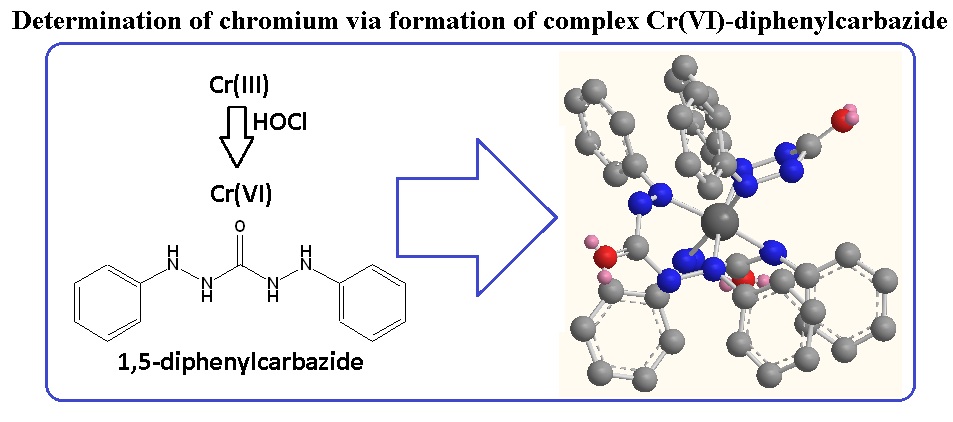Development of Spectrophotometric Method for Determination of Chromium Species Using Hypochlorite Agent Based on the Formation of Cr(VI)-Diphenylcarbazide Complex
Abstract

Research of speciation analysis Cr(III) and Cr(VI) using hypochlorite and peroxide oxidants with Visible Spectrophotometry has been proposed. This research was carried to obtain optimum conditions of oxidation process Cr(III) into Cr(VI) and the formation of Cr(VI)-Diphenylcarbazide complex to the wavelength, complexing time, oxidizing agent (oxidant) concentration, oxidation temperature, pH, and the influence of foreign ion, so it can be proposed as an alternative method for speciation analysis of Cr(III) and Cr(VI). Optimization results show that the maximum wavelength of Cr(VI)-diphenylcarbazide complex is 542 nm by the stable complex time 16-30 minutes using a hypochlorite (HOCl) oxidant concentration 1 x 10-3 M, temperature 60 oC and pH 1. This method is compared with standard method. The presently developed method is more simple and faster than standard method. Regarding accuracy and precision, the method is quite comparable with the standard methods.
Key words: speciation, Cr(III), Cr(VI), oxidant, hypochlorite, spectrophotometry VIS
References
Barrera-Diaz, Violeta Lugo-Lugo, Bryan Bilyeu, J. Hazard. Mater., 2012, 223, 1-12. [2] Bobrowski, A., Mocak, J., Dominik, J., Pereira, H., Bas, B., & Knap, W., Acta Chim. Slov., 2004, 51(1), 77-93. [3] Carvalho LS de, Costa ACS, Ferreira SLC, Teixeira LSG, J. Braz. Chem. Soc., 2004, 15 (1), 153-157. [4] Collins, B.J., Stout, M.D., Levine, K.E., Kissling, G.E., Melnick, R.L., Fennell, T.R., Walden, R., Abdo, K., Pritchard, J.B., Fernando, R.A., Burka, L.T. & Hooth, M.J., Toxicol. Sci., 2010, 118:2:368. [5] Ghaedi M, Asadpour E, Vafaie A., Spectrochim. Acta A: Mol. Biomol. Spectrosc., 2006, 63 (1), 182-188. [6] Kumar KG, Muthuselvi R, J. Anal. Chem., 2006, 61, 28-31. [7] Laurie McNeill, Joan McLean, Marc Edwards, and Jeffrey Parks, State of the Science of Hexavalent Chromium in Drinking water, 2012, Water Research Foundation, Denver Colorado. Can be accessed from http://db.materialoptions.com/ASETSDefense/SEDB/ESOH/Water%20RF_state%20of%20Hex-Cr_science%20(2).pdf [8] McCarroll, N., Keshava, N., Chen, J., Akerman, G., Kligerman, A. & Rinde, E, Environ. Mol. Mutagen., 2010, 51, 2, 89-111. [9] Motomizu, S., Jitmanee, K., Oshima, M., Anal. Chim. Acta, 2003, 499, 149-155. [10] Oktor K., S. Yılmaz, G. Turker and E. Erkus, Environ. Monit. Assess., 2008, 141 (1-3), 97-103.
Refbacks
- There are currently no refbacks.









